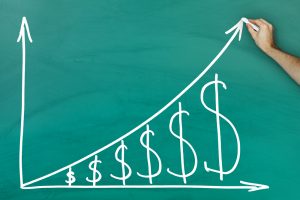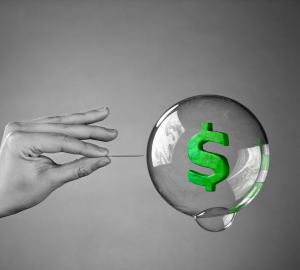
By Richard Morey
November 4, 2022
 A Bear Market Rollercoaster.
A Bear Market Rollercoaster.
As we’ve all witnessed this last month, in October everything reversed. What remained, to put it lightly, were highly unusual occurrences. In view of unchanged economic realities, I believe this will simply turn out to be yet another ill-fated stock market rally attempt. Therefore, today’s report will be an abbreviated analysis.
(For a more in-depth look, please see last month’s report, archived in the Resources section of our website.)
The Dow Jones Industrial Average, which tracks stock prices of the 30 largest US companies, had its best month since January of 1976, gaining 13.95%. As I’ve mentioned in past reports, the best months in the history of the stock market have always occurred during bear markets. What is noteworthy is the extent of this reversal. For the year, the Dow remained down -11.53% (YTD through 10/31/22).
Most investors are more impacted by the S&P 500 stock index, which rose 7.99% in October, ending down -21.12% YTD.
Unfortunately, retired investors are also impacted by the bond market. For the month the broad aggregate US bond market dropped -1.30%, leaving it down –15.54% for the year.
Finally, we have technology stocks. For the month the NASDAQ index rose 3.90%, leaving it still down -32.73% YTD.
Why did stocks rise in October?
Five reasons were most commonly cited last month on Bloomberg:
1. Markets were again inundated with talk about the Fed slowing down its interest rate increases. Several other central banks around the world have been talking along those lines, so perhaps our Fed will listen and soften its tone on further rate increases here?2. Corporate earnings season wasn’t the disaster everyone thought likely. Yes, the large “bell-weather” tech companies, including Meta, Alphabet, Intel & the entire semiconductor industry, and (ominously for the economy) Amazon, had bad quarters. However, the rest of the companies – on the whole – held up better than expected.
3. A few weeks ago the markets were dealing with Great Britain on the brink of…. We’re not sure what. That’s a large economy and one of the world’s largest financial centers. Their recently removed PM, Liz Truss, truly went off the rails. Nobody in Great Britain had ever proposed anything that ignorant. They acted as if they either had no idea inflation was ravaging their people, or they actually wanted it to spike higher.
Or the markets would decide it for them, which they did in short order. A plunging currency, on an island that imports almost everything, in an economy where inflation begins at 10%, is a recipe for immediate, certain financial catastrophe. In this case the crisis began the day their hairbrained economic ideas were translated into proposed policy, and ¬¬¬¬six weeks after embarking on “Trussonomics,” on October 20th, she became the shortest-serving PM in British history. Risk markets were relieved when the new PM, Rishi Sunak, reversed the previous Tory Party economic plans as envisioned by Liz Truss.
4. The Bureau of Economic Analysis “Advance Estimate” for Third Quarter GDP came in at 2.6%. This relieved markets by removing the fear a 3rd negative GDP print would be impossible to ignore, i.e. we would be confirmed by all to be in recession.
5. The US Dollar & Interest Rates. All year long – until October – the US dollar, and yields on US bonds, have been rising. As October progressed this began to reverse – fairly strongly in the case of the dollar.
In worldwide recessions, and accompanying bear markets for risk assets, one would expect the world’s reserve currency – always considered the safest place for money in the world – to rise until the crisis phase was over (perhaps longer). When that reserve currency also happens to pay some of the highest interest rates in the world, as  in today in the US, the currency has two large winds behind its back. High rates + worldwide economic/market risk = higher US dollar.
in today in the US, the currency has two large winds behind its back. High rates + worldwide economic/market risk = higher US dollar.
In October that big trend reversed, as the entire world investment community agreed with US investors that perhaps there was some hope for the world economy moving forward.
Summary of Stocks in October
This summary contains what I consider the most likely order of what occurred in October, in terms of time and causation. As the dollar fell, world optimism peeked its head out later in October. This eased up worldwide liquidity, which immediately spread to the US – where liquidity shot up as the dollar continued to fall. All this was then reflected in the Dow having its best month since 1976.
In other words, at this point, the US dollar is driving everything. I predict risk assets will rise nearly every single day the dollar falls, and vice versa. The dollar fell in October, so stocks rose.
The reason for the dollar’s paramount position in determining economics, and market behavior, involves its role as the “valve” keeping immense financial pressure on the most borderline country economies. This includes Great Britain, the Eurozone and, most believe, Japan. Even excluding those economies, the “developing market” nations borrowed many trillions denominated in the US dollar. This is killing them – here and now.
The US dollar has risen 16% versus other currencies this year.
I would therefore say stock investors felt a sight of relief in October as some of that pressure was relieved, as the dollar finally started to cool off (a little). Of course, hardly any of our investors know about the dollar and the damage its strength has been causing other economies this year. But they can see crises lessening overall, and global fear falling, with any pullback of the dollar.
 I’m sorry to pop stock investors’ bubble, however.
I’m sorry to pop stock investors’ bubble, however.
If you look at the things which led to a sigh of relief on the part of markets in October, you can easily see not one of them addresses the reasons stocks have fallen 20% this year. Every single risk confronting the world economy continues to confront us, with no resolution for any of the problems in sight. That’s true here and abroad.
This month I’ll refer to any of our previous reports, most of which have a section devoted to the brewing problems in Europe and China. From my perspective, that’s where the real action is occurring. Assuming every country outside the USA qualifies as “worldwide,” we’re headed headlong into a worldwide recession. Our economy can’t thrive when either Europe or China’s economies succumb to such economic contraction – let alone the entire world.
What Surprised Us in October?
– a Note for Clients
Stocks having a great month wasn’t even slightly surprising – I was almost sure we’d have one more great month for stocks in 2022. What surprised and relieved me was the performance of the managed futures industry in October.
Almost by design, managed futures do not do well during the exact moments of dramatic shifts in momentum in markets. Fortunately, and also by design, they do control the risk throughout by keeping, for example, 75% in cash at all times. Then I myself control it further if and when needed.
So I never worry about the risk going off the rails when using managed futures. What I do worry about is when I see them getting hit with the worst market conditions for all their approaches. The worst condition I can think of is a worldwide shift from risk-off to risk-on affecting all asset classes. This means the worst condition that can occur for managed futures appeared in October.
If you had told me nearly all the markets would have a sharp, 180-degree turn in October, I would have been bracing for 6% losses in the managed futures index. Instead, the five managed futures funds we own in our Tactical Allocation Portfolio (TAP) pulled back a combined -.9% in October. Our largest holding, Campbell Strategic Macro, actually rose – in this case +.53% – in a uniquely difficult market situation for trading managed futures. Up +37.70% now year-to-date, the more I watch that fund the more impressed I’ve become. ( Nov. 2)
That was, obviously, a very welcome surprise. Most importantly, it highlights how the best algorithms in the market (which we believe are represented by the five funds we own), were written to reap profits when an asset has roared. When done successfully, this can translate, for example, into gaining large profits, over 9 months, on long US dollar futures, and then selling them as October began.
Their algorithms did the same thing with commodities earlier in the year. Commodities roared +50%, before retreating -30% in a few weeks. While I don’t have access to the trading the funds do, if you look closely you can start to see what they’ve been up to. It’s called make high returns when big asset classes have a run, sell before they come tumbling down, invest that money in another asset beginning its run, rinse and repeat.
Their algorithms are quite complex and involve huge amounts of research and data. They do, however, boil down to: Buy early on a highly diversified group of asset classes – each of which purchased after having recently achieved “momentum,” and then sell once your limits have been met. Do that over and over with historically proven algorithms.
The bottom line is that it should be easy to make outsized returns in managed futures with the next flip of the markets into “risk-off.” They just weathered a sharp reversal, to full “risk-on”, with less than 1% losses (in TAP’s case).
This time we’re ready – as the managed futures funds have been all year.
SMILE ZONE
1) A man wakes up after 30 years in a coma.
The first thing he does is call his bank. It turns out that, because of his shrewd investments, the total value of his portfolio is $950 billion.
Thrilled, he jumps out of bed and runs to the hospital cafeteria to celebrate with a cup of coffee.
The cashier tells him “That’ll be $30 billion.”2) Inflation in the US is so bad right now that…
– My friend received a pre-declined credit card in the mail.
– CEO’s are now playing miniature golf.
– Exxon-Mobil laid off 25 Congressmen.
– McDonald’s is selling the 1/4 ouncer.
– A picture is worth 1000 letters.3) When Putin began his first term in office in 1999, he asked the then outgoing president Boris Yeltsin if he had any advice for him since he, Putin had no prior experience in politics.
Yeltsin reportedly handed him two envelopes and said, “If things go bad, open the first envelope. If things go really, REALLY bad, open the second envelope.”
In 1999 till early 2000, things got really bad. The Russian Central Bank defaulted in 1998 and the effects were felt everywhere. Unemployment was rife, stores were empty and people were in the streets hungry, angry and protesting.
In desperation, Putin reached for the bottom drawer and pulled out the first envelope. In a small note, it was typewritten “Blame your predecessor”.
Putin blamed Boris Yeltsin, his predecessor, for the woes of Russia, and for the dissolution of the Soviet Union as the biggest disaster in history. He told his compatriots, “Give me time and power, and I’ll return Russia to greatness!”
It is now 2022– with the Russian Central Bank near default, people protesting in the streets, an economy in shambles, and most alarmingly, a war that isn’t going well. Glumly, Putin opens the second envelope in the bottom drawer.In that second envelope, there is a neatly typewritten note with the message “Prepare two envelopes.”
